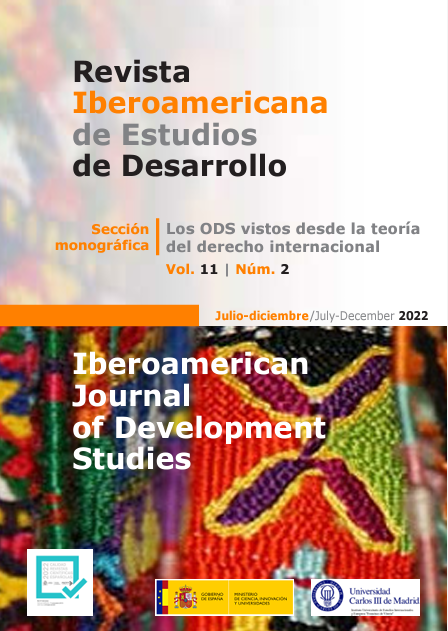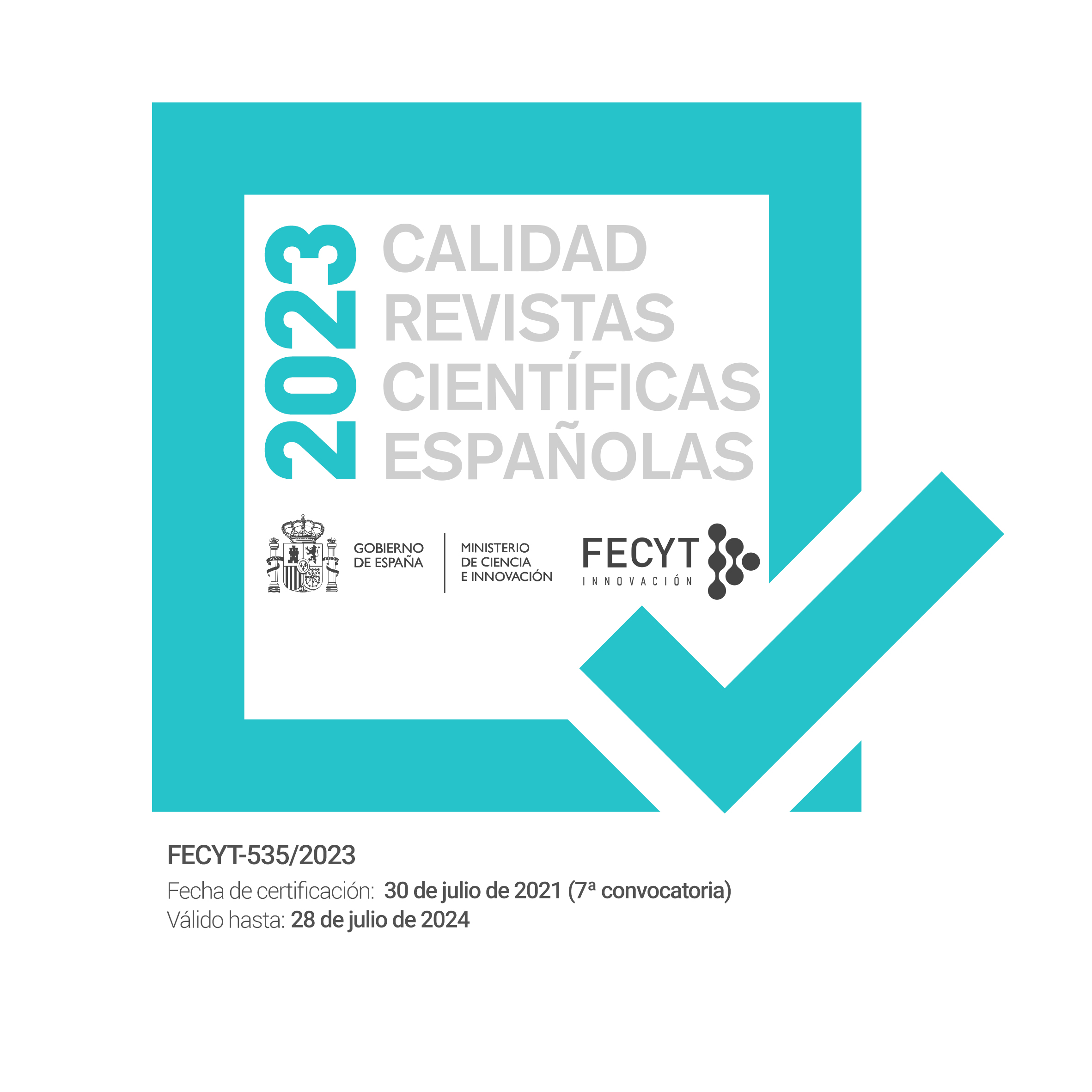The Sustainable Development Goals and the application of International Law: the case of the Grand Ethiopian Renaissance Dam
DOI:
https://doi.org/10.26754/ojs_ried/ijds.691Palabras clave:
Gran Presa del Renacimiento Etíope, desarrollo sostenible, interpretación, integración sistémica, fragmentación, conflicto entre normasResumen
En este artículo, se examina el papel que desempeñan los Objetivos de Desarrollo Sostenible en la interpretación armoniosa y la integración sistémica del derecho internacional. El telón de fondo para evaluar dicha hipótesis es el conflicto entre Etiopía, Sudán y Egipto, que surgió a raíz de la construcción de la Gran Presa del Renacimiento Etíope. Considerando la amplia gama de intereses en juego y los diferentes regímenes especiales de derecho internacional que pueden aplicarse a la solución de tal controversia, en este trabajo se argumenta que una perspectiva basada en la noción de desarrollo sostenible puede contribuir a facilitar el diálogo entre las partes y asegurar el cumplimiento de sus obligaciones internacionales recíprocas. Centrándose en la interpretación armoniosa de los diferentes regímenes que convergen en este conflicto, se propone que la Agenda 2030 para el Desarrollo Sostenible opere como una lente caleidoscópica con el fin de armonizar, en cierta medida, las obligaciones internacionales.
Descargas
Citas
GATHMANN S (2021). Nile dam dispute: Sudan, Egypt, Ethiopia agree to hold more talks. Aljazeera. https://www.aljazeera.com/news/2021/1/3/nile-dam-dispute-sudan-egypt-ethiopia-agree-to-hold-more-talks, access February 2, 2021.
KENNEDY D (2008). The Mystery of Global Governance. Ohio Northern University Law Review 34:827.
KIM RE (2016). The Nexus between International Law and the Sustainable Development Goals. Review of European, Comparative and International Environmental Law 25(1):15.
KLABBERS J (2011). Beyond the Vienna Convention: Conflicting Treaty Provisions. In E. Cannizzaro (ed.). The Law of Treaties Beyond the Vienna Convention. Oxford University Press, Oxford, pp. 192-205.
KOSKENNIEMI M (2006). From Apology to Utopia. Cambridge University Press, Cambridge.
MCCORQUODALE R, MCINERNEY-LANKFORD S (2020). Sustainable Development and International Law. Proceedings of the ASIL Annual Meeting 114:141-143.
PAPPIS I, SAHLBERG A, WALLE T, BROAD O, ELUDOYIN E, HOWELLS M, USHER W (2021). Influence of Electrification Pathways in the Electricity Sector of Ethiopia ‒ Policy Implications Linking Spatial Electrification Analysis and Medium to Long-Term Energy Planning. Energies 14(4):1209.
PAUWELYN J (2003). Conflict of Norms in Public International Law: How WTO Law Relates to other Rules of International Law. Cambridge University Press, Cambridge.
SALMAN SMA (2016). The Grand Ethiopian Renaissance Dam: the road to the declaration of principles and the Khartoum document. Water International 41(4):512-527.
SIMMA B (2011). Foreign investment arbitration: A place for human rights? International and Comparative Law Quarterly 60(3):573-596.
VESELINOVIC M (2015). Ethiopia’s $5bn project that could turn it into Africa’s water powerhouse. CNN World, October 20. https://edition.cnn.com/2015/03/06/africa/grand-reneissance-dam-ethiopia/index.html , access February 2, 2021.
WHEELER KG, JEULAND M, HALL JW, ZAGONA E, WHITTINGTON D (2020). Understanding and managing new risks on the Nile with the Grand Ethiopian Renaissance Dam. Nature Communications 11(1):1-9.
WOUTERS P, VINOGRADOV S, MAGSIG BO (2008). Water Security, Hydrosolidarity, and International Law: A River Runs Through It… Yearbook of International Environmental Law 19(1):97-134.
International Treaties and Other International Instruments
African Charter on Human and Peoples’ Rights (adopted June 27, 1981, entry into force 21 October 1986). United Nations, Treaty Series 1520:217.
Agreement for the Full Utilization of the Nile Waters, November 8, 1959. United Nations, Treaty Series 453:51.
Charter of the United Nations (UN Charter) (adopted June 26, 1945, entry into force 4 October 1945). United Nations, Treaty series 1: XVI.
Convention on Biological Diversity (adopted June 5, 1992, entry into force 29 December 1993). United Nations, Treaty Series 1760:79.
Exchange of Notes between Her Majesty’s Government in the United Kingdom and the Egyptian Government on the Use of Waters of the Nile for Irrigation, May 7, 1929. https://www.internationalwaterlaw.org/documents/africa.html#Nile%20River%20Basin , access October 18, 2021.
International Covenant on Economic, Social and Cultural Rights (ICESCR) (adopted December 16, 1966, entry into force January 3, 1976). United Nations, Treaty Series 993:3.
International Law Association (1967). Helsinki Rules on the Uses of the Waters of International Rivers, adopted by the International Law Association at the 52nd Conference, Helsinki, Finland, August 1966. International Law Assotiation, London.
International Law Commission (2001). Draft articles on Prevention of Transboundary Harm from Hazardous Activities, adopted by the International Law Commission at its fifty-third session, in 2001, A/CN.4/SER.A/2001/Add.1(A/56/10). Yearbook of the International Law Commission II (2):229.
International Law Commission (2006). Fragmentation of International Law: Difficulties Arising from the Diversification and Expansion of International Law, Report of the Study Group of the International Law Commission (April 13, 2006), A/CN.4/L.682.
The World Bank (2021). World Development Indicators. https://data.worldbank.org/indicator/EG.ELC.ACCS.ZS?view=chart, access April 3, 2021.
Treaties Between the United Kingdom and Ethiopia, and Between the United Kingdom, Italy, and Ethiopia, Relative to the Frontiers Between Soudan, Ethiopia and Eritrea, May 15, 1902. Printed for his Majesty’s Stationarey Office, Treaty Series 16.
Treaty Establishing the Common Market for Eastern and Southern Africa (COMESA) (conclusion November 5, 1993, entry into force December 8, 1994). United Nations, Treaty series 2314:265.
UN Committee on Economic, Social and Cultural Rights (2003). General Comment No. 15: The Right to Water (arts. 11 and 12 of the Covenant). Adopted at the Twenty-ninth Session of the Committee on Economic, Social and Cultural Rights (January 20, 2003), E/C.12/2002/11.
UN Conference on Environment and Development (1992). Rio Declaration on Environment and Development. Reports of the United Nations Conference on Environment and Developmen, A/CONF.151/26 (vol. I).
UN General Assembly (1962). Resolution 1803 (XVII) Permanent Sovereignty over Natural Resources (4 December 1962), A/RES/1803(XVII).
UN General Assembly (1986). Resolution 41/128 Declaration on the Right to Development (4 December 1986), A/RES/41/128.
UN General Assembly (1997). Resolution 51/229 Convention on the law of the non- navigational uses of international watercourses (July 8, 1997), A/RES/51/229.
UN General Assembly (2010). Resolution 64/292. The human right to water and sanitation (July 28, 2010), A/RES/64/292.
UN General Assembly (2012). Resolution 66/288 The future we want (July 27, 2012), A/RES/66/288.
UN General Assembly (2015). Resolution 70/1 Transforming our world: the 2030 Agenda for Sustainable Development (September 25, 2015), A/RES/70/1.
UN General Assembly (2018). Resolution 73/1 Political declaration adopted at the Nelson Mandela Peace Summit (October 3, 2018), A/RES/73/1.
United Nations Convention to Combat Desertification in those Countries Experiencing Serious Drought and/or Desertification, particularly in Africa (signed October 14, 1994, entry into force December 26, 1996). United Nations, Treaty Series 1954:3.
United Nations Framework Convention on Climate Change (signed May 9, 1992, entry into force March 21, 1994). United Nations, Treaty Series 1771:107.
Vienna Convention on the Law of Treaties [VCLT] (adopted May 23, 1969, entry into force January 27, 1980). United Nations, Treaty Series 1155: 331.
World Commission on Environment and Development (1987). Report of the World Commission on Environment and Development: Our Common Future (August 4, 1987), A/42/427.
World Summit on Sustainable Development (2002). Report of the World Summit on Sustainable Development (August 26-September 4, 2002). A/CONF.199/20.
Decisions of International Adjudicative Bodies
International Court of Justice (1957). Case concerning the Right of Passage over Indian Territory (Preliminary Objections). ICJ Reports 1957:125.
International Court of Justice (1996). Legality of the Threat or Use of Nuclear Weapons (Advisory Opinion). ICJ Reports 1996:226.
International Court of Justice (1997). Gabcíkovo-Nagymaros Project (Judgement). ICJ Reports 1997:7.
International Court of Justice (2004). Legal Consequences of the Construction of a Wall in the Occupied Palestinian Territory (Advisory Opinion). ICJ Reports 2004:136.
International Court of Justice (2005). Case Concerning Armed Activities on the Territory of the Congo (Democratic Republic of the Congo v. Uganda) (Judgement). ICJ Reports 2005:168.
Descargas
Publicado
Cómo citar
Número
Sección
Licencia
Derechos de autor 2022 Mariona Cardona-Vallès, Sebastián Preller-Bórquez

Esta obra está bajo una licencia internacional Creative Commons Atribución-NoComercial-SinDerivadas 4.0.








